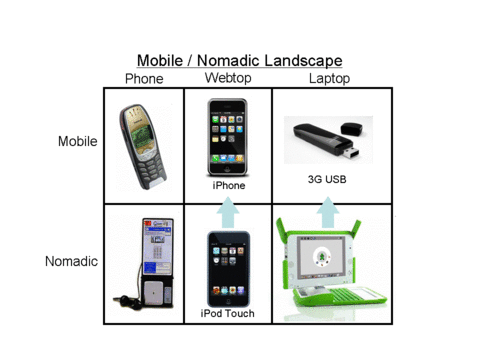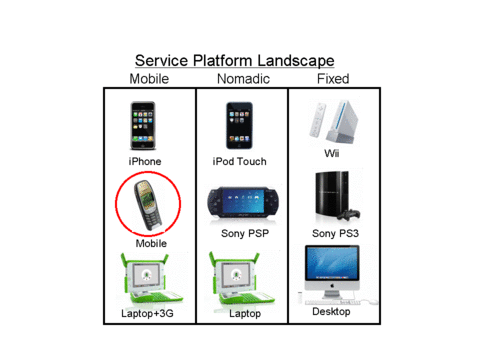On the 16th January Apple App Store achieved 500 million downloads, granted most of the downloads are for free applications. But regardless this is a great achievement and a testament to focusing upon the needs of the customer and application developer. The Apple App Store was not the first App Store, some of its predecessors include: O2 Revolution, Verizon AppZone, 3 X-Series, Mobile2Market, Windows Mobile Catalog, NGage, Nokia Download Store, etc. An important factor in its success is it caters for one platform common to two devices, the iPhone and the iPod Touch.
Comparing the iPhone and iPod Touch, on form factor the iPhone is bigger and heavier than the Touch. It weighs in at 4.8 ounces and 11.6 mm depth versus the Touch’s 4.2 ounces and 8mm thickness. The biggest gap in my personal experience is playback time for the iPod Touch I can get 38 hours (claimed 36) versus <18 hours for the iPhone (claimed 36 hours) because it’s also a phone, not just a player.
Trying to find the number of iPod Touch devices on the market has proven challenging. Gathering data from sources such as Admob latest impression figures, on Amazon.com the iPod Touch remains the top selling MP3 player, and other estimates on MP3 market shares. In 2008 the total MP3 player unit sales was 250m, so even if just 4.5% of the market is iPod Touch, that’s over 10 million devices sold in ’08. If you check out your local Walmart or Target, you’ll see inventories are low; the iPod Touch proved a popular present, as reflected in Apple’s recent numbers were it made a record net profit of $1.61bn and posted record revenue of $10.7bn for the quarter to the end of December. Apple sold more than 22 million iPods and more than four million iPhones in that quarter. This means that potentially over half the downloads in the App Store are from the iPod Touch, and it looks like it’s the faster growing of the two devices.
What’s opening up is an interesting spectrum of mobile / nomadic usage, see diagram below, at one end the mobile phone that’s small, lightweight and doesn’t need recharging every day, on the other end laptops. Then in the middle the iPhone and iPod Touch. The iPhone provides the functionality of a phone and a good-enough web/entertainment experience; while the iPod Touch provides that good-enough web/entertainment experience in your pocket. For some customers their existing phone is good enough, and the iPod Touch provides a good enough player/portable games device/web experience. For others the iPhone provides the convergence of both. For others the iPod Touch is simply a cool MP3 player and games machine. This raises a critical issue for operators, what should they use as a framework for comparison of app store performance?

Should the iPod Touch usage statistics be counted as part of the iPhone stats, especially when comparing to other smart-phones? They’re apps that are being purchased, or at the least free and downloaded; but if they are included why not include downloads of games and content to other devices such as games consoles? Should the iPod Touch downloads only be compared to Sony PSP (44M sold) downloads, or to other devices such as the Sony PS3 (20M sold) or the Nintendo Wii (46M sold)? Should games be broken out as a separate category? A simple answer is: “a download is a download,” regardless of what the device is capable of or the download used for – they’re generally going over an operators network.
The diagram below shows the spectrum of service platforms, from fixed devices such as the Nintendo Wii and desktop PC, to nomadic devices such as the Sony PSP and iPod Touch, to fully mobile devices. The market breaks down into devices where the manufacturer controls most of the application action; though for example with the Wii, once you have the web browser installed you can go direct to the BBC iPlayer site to download shows. The pervasiveness and processing power of laptops and desktops generally enables service providers to deliver their services with minimal control from the device manufacturer. But the phone is an enigma in this landscape. Most phone manufacturers have failed to dominate like Apple; the lack of processing power and limited functionality of phone browsers has limited over the top providers; so operators have filled the gap. But increasingly today the apps offered through those operator stores pale in comparison to the Apple App Store. So operators have to raise their game to that of Apple, Sony and Nintendo.

Examining the advantages Apple, Sony and Nintendo have:
- Generally a ‘one platform store’ so effort is focused on ensuring compatibility and quality.
- Beautifully simple yet visually pleasing user experience, it encourages you to linger and shop around;
- Developers needs have been met with:
- A simple revenue share (70/30) or license agreement, hence a clear path to cash;
- A market size measured in tens of millions of units, for example the iPhone and iPod Touch combined is likely greater than 20m devices, the Nintendo Wii has sold 46M units;
- A platform commitment measured in years, not months – as is the case with many phone manufacturers; and
- Direct access to customers.
For operators this has several implications:
- They need to work together to achieve a similar market size because only a fraction of their customers’ devices are truely addressable;
- They need to focus on a few platforms, and commit to them over multiple years;
- Get the browser issue sorted as soon as possible, so service innovation is made easier. This has its risks, but they’re being left behind;
- Get out of the way and let the customer and application developer innovate; and
- Make the user experience simple yet visually pleasing, the App Store is on the home page of the device, the customer just clicks and starts downloading cool stuff.
The challenge is this requires co-ordination across device manufacturers, operators and multiple groups within the operator. For operators the decision is back to my crossroad analogy from the MWC weblog entry last year: “Operators take a left and follow the ISP route, or continue along the current strategy, or perhaps take a right along a path that enables and enhances services over their network.” The left route requires drastic downsizing to that of a utility business, continuing along the current path is untenable, the right route requires whole organization and value chain commitment. Today’s piecemeal approaches are not competitive with other app stores to which they will be judged by the customer. As discussed in this previous weblog article, its customers’ expectations that are changing the game, and at the moment they are changing it faster than operators are responding.